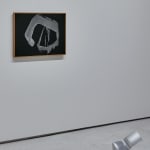Morita Shiryū (1912–1998)
En
Aluminum flake pigment on paper, framed
c. 1969
With a label signed by Inada Sousai
53 x 74 cm
55 x 76 cm (overall)
c. 1969
With a label signed by Inada Sousai
53 x 74 cm
55 x 76 cm (overall)
Literature
Morita Shiryu Catalogue Raisonné: 1952–1998. Uji: Soryusha, 2019.
The subject matter en, the circle, is a symbol of the central importance in Zen, and it has been taken up by various modern artists, perhaps most prominently Yoshihara Jiro of the Gutai group. In Japanese and Chinese tradition, the circle has for centuries been used to represent spiritual concepts of infinity, eternity, the circle of life and oneness with the universe. In that sense, Morita here claims his part of a long lineage of artistic heritage while using contemporary means of expression.
Morita began his En with an upward-stroke near the center-left of the composition, then completing the character in a clockwise, spiraling single stroke. In traditional Zen painting, the circle is often shown as a strictly geometric shape, with specific nuances conferred by adding further inscriptions in the surrounding space. Morita tries once more to fuse writing and painting by writing in a manner that the character en virtually becomes the circle. He achieves this by reducing the thirteen brushstrokes normally required to just one continuous stroke. The shikkin (lacquer and gold) technique of using aluminum flake pigment in glue medium, unique to Morita, accentuates the spontaneity of his brush movements and creates a sense of timelessness.
By the mid-1960s, Morita’s work was heavily charged with his spiritual leanings. He initially started studying Zen under the guidance of Hisamatsu Shin’ichi, the leader of the Kyoto School of Philosophy. Hisamatsu’s teachings gravitated towards the idea of absolute nothingness as the underlying truth of all existence. As Morita explained, absolute nothingness to him signified the ultimate condition of reality, a state of final release from the subject-object dichotomy, known as the void or nirvana.
Morita Shiryu (avant-garde calligrapher; 1912–1998)
Avant-garde calligrapher from Hyogo Prefecture. Like fellow artist Inoue Yuichi, Morita studied under the calligraphy master Ueda Sokyu. He co-founded the avant-garde group Bokujinkai together with Inoue and was the founder and editor of the journal Bokubi (Beauty of Ink), both of which revolutionized traditional Japanese calligraphy and spread knowledge of Japanese avant-garde calligraphy to an international audience. He was posthumously awarded the Medal of Honor with Dark Blue Ribbon.
Morita began his En with an upward-stroke near the center-left of the composition, then completing the character in a clockwise, spiraling single stroke. In traditional Zen painting, the circle is often shown as a strictly geometric shape, with specific nuances conferred by adding further inscriptions in the surrounding space. Morita tries once more to fuse writing and painting by writing in a manner that the character en virtually becomes the circle. He achieves this by reducing the thirteen brushstrokes normally required to just one continuous stroke. The shikkin (lacquer and gold) technique of using aluminum flake pigment in glue medium, unique to Morita, accentuates the spontaneity of his brush movements and creates a sense of timelessness.
By the mid-1960s, Morita’s work was heavily charged with his spiritual leanings. He initially started studying Zen under the guidance of Hisamatsu Shin’ichi, the leader of the Kyoto School of Philosophy. Hisamatsu’s teachings gravitated towards the idea of absolute nothingness as the underlying truth of all existence. As Morita explained, absolute nothingness to him signified the ultimate condition of reality, a state of final release from the subject-object dichotomy, known as the void or nirvana.
Morita Shiryu (avant-garde calligrapher; 1912–1998)
Avant-garde calligrapher from Hyogo Prefecture. Like fellow artist Inoue Yuichi, Morita studied under the calligraphy master Ueda Sokyu. He co-founded the avant-garde group Bokujinkai together with Inoue and was the founder and editor of the journal Bokubi (Beauty of Ink), both of which revolutionized traditional Japanese calligraphy and spread knowledge of Japanese avant-garde calligraphy to an international audience. He was posthumously awarded the Medal of Honor with Dark Blue Ribbon.



